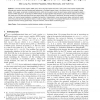Free Online Productivity Tools
i2Speak
i2Symbol
i2OCR
iTex2Img
iWeb2Print
iWeb2Shot
i2Type
iPdf2Split
iPdf2Merge
i2Bopomofo
i2Arabic
i2Style
i2Image
i2PDF
iLatex2Rtf
Sci2ools
122
click to vote
ICDE
2005
IEEE
2005
IEEE
Reverse Nearest Neighbors in Large Graphs
A reverse nearest neighbor (RNN) query returns the data objects that have a query point as their nearest neighbor (NN). Although such queries have been studied quite extensively in Euclidean spaces, there is no previous work in the context of large graphs. In this paper, we provide a fundamental lemma, which can be used to prune the search space while traversing the graph in search for RNN. Based on it, we develop two RNN methods; an eager algorithm that attempts to prune network nodes as soon as they are visited and a lazy technique that prunes the search space when a data point is discovered. We study retrieval of an arbitrary number k of reverse nearest neighbors, investigate the benefits of materialization, cover several query types, and deal with cases where the queries and the data objects reside on nodes or edges of the graph. The proposed techniques are evaluated in various practical scenarios involving spatial maps, computer networks, and the DBLP coauthorship graph.
Database | DBLP Coauthorship Graph | ICDE 2005 | Reverse Nearest Neighbor | Reverse Nearest Neighbors |
| Added | 01 Nov 2009 |
| Updated | 01 Nov 2009 |
| Type | Conference |
| Year | 2005 |
| Where | ICDE |
| Authors | Man Lung Yiu, Dimitris Papadias, Nikos Mamoulis, Yufei Tao |
Comments (0)

